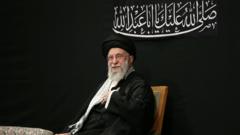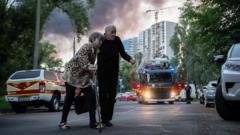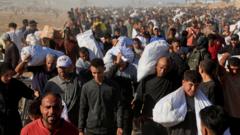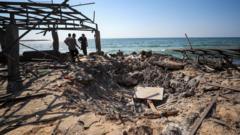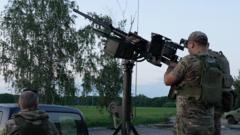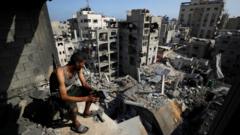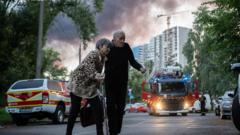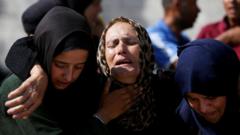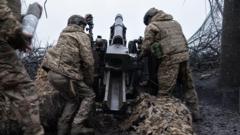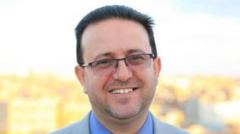**An Israeli airstrike targeting a suspected Hezbollah facility has triggered widespread fear and chaos in schools in Dahieh, highlighting the community's trauma and ongoing tension in the region.**
**Schools in Beirut Suburb on Edge Following Israeli Strikes**
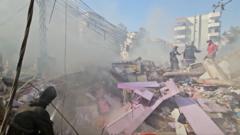
**Schools in Beirut Suburb on Edge Following Israeli Strikes**
**Residents Concerns Rise Amid Renewed Hostilities in Southern Beirut**
In a startling incident reminiscent of the recent past, schools in the southern suburb of Beirut, Dahieh, faced unwarranted panic following an urgent warning issued by the Israel Defense Forces (IDF). The warning, disseminated via social media, indicated the imminent threat of an airstrike aimed at a building identified as a Hezbollah site. Accompanied by a map marking nearby schools for immediate evacuation, the announcement set off a wave of chaos as parents rushed to fetch their children while residents fled the area in fear.
Ahmad Alama, the principal of St. Georges School, vividly described the scene: "It was total chaos. We tried to contain the situation, but it was crazy." This marked the first instance of Israeli forces striking Dahieh since the ceasefire was established last November, which had brought an end to 13 months of conflict between Israel and Hezbollah.
The escalation followed a rocket attack from southern Lebanon, which Israel deemed a violation of the ceasefire. Hezbollah refuted any involvement. Mr. Alama reflected a sentiment shared by many in the community, stating, "We thought the war had ended with the ceasefire, but unfortunately, we're still living it every day."
Despite the ceasefire, Israeli military operations targeting Hezbollah remain prevalent, particularly in southern Lebanon. The ongoing strikes have only heightened fears of a complete return to war, especially following a recent attack that led to the death of a Hezbollah commander.
Schools, once closed during the conflict, are making efforts to prepare for potential emergencies. St. Georges School now has evacuation protocols in place, including designated safe rooms and communication plans to avoid a repeat of last month’s chaos. Yet the trauma of witnessing destruction close to home remains pervasive among students and staff alike.
Mr. Alama noted that in spite of the pervasive tension, the school has expanded its extracurricular programming rather than reducing it — a decision made with the intent of supporting students’ mental well-being.
As the community wrestles with the aftermath of past destruction, the physical remnants of conflict linger, presenting ongoing psychological challenges. Many buildings remain in ruins from previous airstrikes, a stark reminder of the violence that has swept through the area. Yet, shops and cafes are bustling again, as residents try to return to normalcy.
However, concerns linger as the local population faces renewed uncertainty. With aid from Hezbollah for residential repairs and pledges from the government for reconstruction funding still in limbo, the prospect of large-scale rebuilding seems a distant reality. Amid uncertainty, the community’s resilience is tested as they confront the ongoing threats to their safety and stability.
Ahmad Alama, the principal of St. Georges School, vividly described the scene: "It was total chaos. We tried to contain the situation, but it was crazy." This marked the first instance of Israeli forces striking Dahieh since the ceasefire was established last November, which had brought an end to 13 months of conflict between Israel and Hezbollah.
The escalation followed a rocket attack from southern Lebanon, which Israel deemed a violation of the ceasefire. Hezbollah refuted any involvement. Mr. Alama reflected a sentiment shared by many in the community, stating, "We thought the war had ended with the ceasefire, but unfortunately, we're still living it every day."
Despite the ceasefire, Israeli military operations targeting Hezbollah remain prevalent, particularly in southern Lebanon. The ongoing strikes have only heightened fears of a complete return to war, especially following a recent attack that led to the death of a Hezbollah commander.
Schools, once closed during the conflict, are making efforts to prepare for potential emergencies. St. Georges School now has evacuation protocols in place, including designated safe rooms and communication plans to avoid a repeat of last month’s chaos. Yet the trauma of witnessing destruction close to home remains pervasive among students and staff alike.
Mr. Alama noted that in spite of the pervasive tension, the school has expanded its extracurricular programming rather than reducing it — a decision made with the intent of supporting students’ mental well-being.
As the community wrestles with the aftermath of past destruction, the physical remnants of conflict linger, presenting ongoing psychological challenges. Many buildings remain in ruins from previous airstrikes, a stark reminder of the violence that has swept through the area. Yet, shops and cafes are bustling again, as residents try to return to normalcy.
However, concerns linger as the local population faces renewed uncertainty. With aid from Hezbollah for residential repairs and pledges from the government for reconstruction funding still in limbo, the prospect of large-scale rebuilding seems a distant reality. Amid uncertainty, the community’s resilience is tested as they confront the ongoing threats to their safety and stability.

